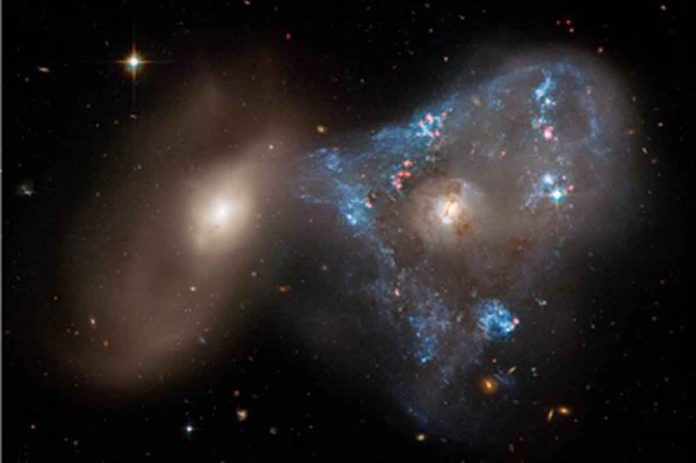A spectacular head-on collision between two galaxies fueled the unusual triangular-shaped star-birthing frenzy. It has been captured in a new image from NASA’s Hubble Space Telescope.
The interacting galaxy duo is called Arp 143. The pair have the glittery, distorted, star-forming spiral galaxy NGC 2445 at right. It has less flashy companion, NGC 2444 at left.
Astronomers suggest that the galaxies passed through each other. It ignites the uniquely shaped star-formation firestorm in NGC 2445. There thousands of stars are bursting to life on the right-hand side of the image. This galaxy is awash in star birth because it is rich in gas. Gas is the fuel that makes stars. But it hasn’t yet escaped the gravitational clutches of its partner NGC 2444. It is there on the left side of the image. The pair is waging a cosmic tug-of-war. NGC 2444 appears to be winning here. The galaxy has pulled gas from NGC 2445. It formed the oddball triangle of newly minted stars.
NGC 2444 is responsible for yanking taffy-like strands of gas from its partner. It has shocked the streamers of young, blue stars. These stars appear to form a bridge between the two galaxies.
These streamers are among the first in what appears to be a wave of star formation. It started on NGC 2445’s outskirts and continued inward. Scientists estimate the streamer stars were born between about 50 million and 100 million years ago. But these stars are being left behind. Because NGC 2445 continues to pull slowly away from NGC 2444.
Stars not older than 1 million to 2 million years are forming closer to the center of NGC 2445. Hubble’s keen sharpness captured some individual stars. These are the brightest and most massive in the galaxy. Most of the blue clumps are groupings of stars.
The pink blobs are giant and young star clusters still enshrouded in dust and gas. But most of the action is happening in NGC 2445. It does not mean the other half of the interacting pair has escaped unscathed. The gravitational tussle has stretched NGC 2444 into an odd shape. The galaxy has no new star birth because it lost its gas before this galactic encounter.

